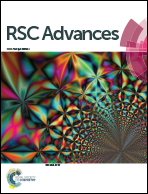Turn-on luminescence based discrimination of protic acids using a flexible layered metal–organic coordination polymer†
Abstract
Micro-sized metal–organic coordination compound [Co(OBA) (H2O)2] (OBA = 4,4′-oxybis(benzoate)) 1 has been synthesized on a gram scale by solvent evaporation method. The two-dimensional structure of the micro-crystals has been confirmed by comparing with the previously reported hydrothermally synthesized compound. The compound was systematically characterized by PXRD, TGA, DSC, IR and SEM studies. The compound shows reversible hydration behaviour and structural flexibility by changing the inter-layers distances. The compound changes its colour to dark blue from the bright pink after heating at 150 °C for 1 hour. The dehydrated blue compound shows weak luminescence centered at 382 nm upon excitation at 273 nm. Luminescence based titration with the addition of traces amount of aqueous solution of various acids with different pKa values such as hydrochloric acid (HCl), nitric acid (HNO3), sulphuric acid (H2SO4), oxalic acid (COOH)2, formic acid (HCOOH), acetic acid (CH3COOH) in dehydrated compound (1′) dispersed in acetonitrile show differential luminescence turn-on according to their pKa values. Similar behaviours have also been observed for amino acids based on their isoelectric point (pI).


 Please wait while we load your content...
Please wait while we load your content...